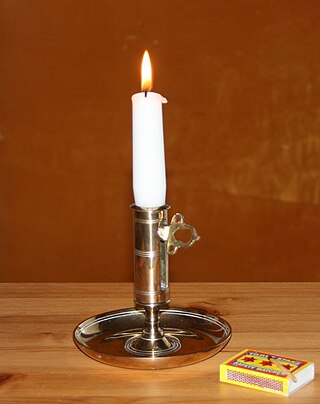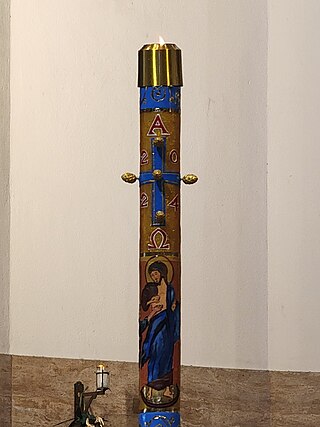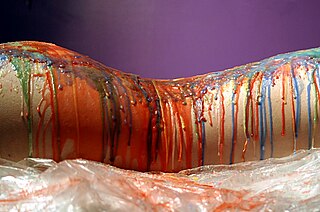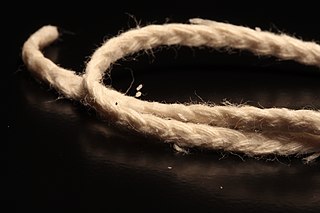
A candle clock is a thin candle with consistently spaced marking that, when burned, indicates the passage of periods of time. While no longer used today, candle clocks provided an effective way to tell time indoors, at night, or on a cloudy day.

A candle clock is a thin candle with consistently spaced marking that, when burned, indicates the passage of periods of time. While no longer used today, candle clocks provided an effective way to tell time indoors, at night, or on a cloudy day.
It is unknown where and when candle clocks were first used. The earliest reference to their use to occurs in a Chinese poem by You Jiangu (AD 520). [1] Here, the graduated candle supplied a means of determining time at night. Similar candles were used in Japan until the early 10th century.
You Jiangu's device consisted of six candles made from 72 pennyweights (24 grains each), of wax, each being 12 inches high, of uniform thickness, and divided into 12 sections each of one inch. Each candle burned away completely in four hours, making each marking 20 minutes. The candles were placed for protection inside cases made of a wooden frame with transparent horn panels in the sides. [1]
Similar methods of measuring time were used in medieval churches.[ citation needed ] The invention of the candle clock was attributed by the Anglo-Saxons to Alfred the Great, king of Wessex. The story of how the clock was created was narrated by Asser, who lived at Alfred's court and became his close associate. [2] Alfred used six candles, each made from 12 pennyweights of wax, and made to be 12 inches (30 cm) high and of a uniform thickness. The candles were marked at intervals of an inch. Once lit, they were protected from the wind by being placed in a lantern made of wood and transparent horn. It would have taken 20 minutes to burn down to the next mark; the candles, burning one after the other, lasted for 24 hours. [3]

Al-Jazari described a candle clock in 1206. [4] It included a dial to display the time and, for the first time, employed a bayonet fitting, a fastening mechanism still used in modern times. [5] The English engineer and historian Donald Routledge Hill described one of al-Jazari's candle clocks as follows:
The candle, whose rate of burning was known, bore against the underside of the cap, and its wick passed through the hole. Wax collected in the indentation and could be removed periodically so that it did not interfere with steady burning. The bottom of the candle rested in a shallow-dish that had a ring on its side connected through pulleys to a counterweight. As the candle burned away, the weight pushed it upward at a constant speed. The automata were operated from the dish at the bottom of the candle. [4]

A burning glass or burning lens is a large convex lens that can concentrate the sun's rays onto a small area, heating up the area and thus resulting in ignition of the exposed surface. Burning mirrors achieve a similar effect by using reflecting surfaces to focus the light. They were used in 18th-century chemical studies for burning materials in closed glass vessels where the products of combustion could be trapped for analysis. The burning glass was a useful contrivance in the days before electrical ignition was easily achieved.

A candle is an ignitable wick embedded in wax, or another flammable solid substance such as tallow, that provides light, and in some cases, a fragrance. A candle can also provide heat or a method of keeping time. Candles have been used for over two millennia around the world, and were a significant form of indoor lighting until the invention of other types of light sources. Although electric light has largely made candle use nonessential for illumination, candles are still commonly used for functional, symbolic and aesthetic purposes and in specific cultural and religious settings.

A crayon is a stick of pigmented wax used for writing or drawing. Wax crayons differ from pastels, in which the pigment is mixed with a dry binder such as gum arabic, and from oil pastels, where the binder is a mixture of wax and oil.

A Paschal candle is a large candle used in liturgies in Western Christianity. A new Paschal candle is blessed and lit every year at Easter. It is used throughout the Eastertide and then throughout the year on casualities such as baptisms, funerals and some other special occasions such as the ordination of priests, taking vows or the Consecration of virgins, when the fire from the Paschal candle is carried with a wick to light another liturgical candle, as for example the baptismal candle.

Incense is an aromatic biotic material that releases fragrant smoke when burnt. The term is used for either the material or the aroma. Incense is used for aesthetic reasons, religious worship, aromatherapy, meditation, and ceremonial reasons. It may also be used as a simple deodorant or insect repellent.

A lantern is a source of lighting, often portable. It typically features a protective enclosure for the light source – historically usually a candle, a wick in oil, or a thermoluminescent mesh, and often a battery-powered light in modern times – to make it easier to carry and hang up, and make it more reliable outdoors or in drafty interiors. Lanterns may also be used for signaling, as torches, or as general light-sources outdoors.

Badīʿ az-Zaman Abu l-ʿIzz ibn Ismāʿīl ibn ar-Razāz al-Jazarī was a Muslim polymath: a scholar, inventor, mechanical engineer, artisan and artist from the Artuqid Dynasty of Jazira in Mesopotamia. He is best known for writing The Book of Knowledge of Ingenious Mechanical Devices in 1206, where he described 50 mechanical devices, along with instructions on how to construct them. One of his more famous inventions is the elephant clock. He has been described as the "father of robotics" and modern day engineering.

Ear candling, also called ear coning or thermal-auricular therapy, is a pseudoscientific alternative medicine practice claiming to improve general health and well-being by lighting one end of a hollow candle and placing the other end in the ear canal. Medical research has shown that the practice is both dangerous and ineffective and does not functionally remove earwax or toxicants, despite product design contributing to that impression.

A water clock or clepsydra is a timepiece by which time is measured by the regulated flow of liquid into or out from a vessel, and where the amount of liquid can then be measured.

In an explosive, pyrotechnic device, or military munition, a fuse is the part of the device that initiates function. In common usage, the word fuse is used indiscriminately. However, when being specific, the term fuse describes a simple pyrotechnic initiating device, like the cord on a firecracker whereas the term fuze is used when referring to a more sophisticated ignition device incorporating mechanical and/or electronic components, such as a proximity fuze for an M107 artillery shell, magnetic or acoustic fuze on a sea mine, spring-loaded grenade fuze, pencil detonator, or anti-handling device.

Wax play is a form of temperature play practiced in a BDSM context, in which wax from a candle is dripped onto a person's naked skin, in order to introduce a slight burning sensation to the skin.

A votive candle or prayer candle is a small candle, typically white or beeswax yellow, intended to be burnt as a votive offering in an act of Christian prayer, especially within the Anglican, Lutheran, and Roman Catholic Christian denominations, among others. In Christianity, votive candles are commonplace in many churches, as well as home altars, and symbolize the "prayers the worshipper is offering for him or herself, or for other people." The size of a votive candle is often two inches tall by one and a half inches diameter, although other votive candles can be significantly taller and wider. In other religions, such as Hinduism and Buddhism, similar offerings exist, which include diyas and butter lamps.

A rushlight is a type of candle or miniature torch formed by soaking the dried pith of the rush plant in fat or grease. For several centuries, rushlights were a common source of artificial light for poor people throughout the British Isles. They were extremely inexpensive to make. English essayist William Cobbett wrote, "This rushlight cost almost nothing to produce and was believed to give a better light than some poorly dipped candles."

Candle making was developed independently in a number of countries around the world.

A candle wick or lamp wick is usually made of braided cotton that holds the flame of a candle or oil lamp. A candle wick works by capillary action, conveying ("wicking") the fuel to the flame. When the liquid fuel, typically melted candle wax, reaches the flame it then vaporizes and combusts. In other words, the wick brings the liquified wax up into the flame to burn. The candle wick influences how the candle burns. Important characteristics of the wick include diameter, stiffness, fire-resistance, and tethering.

The ceremonial use of lights occurs in liturgies of various Christian Churches, as well as in Jewish, Zoroastrian, and Hindu rites and customs.

A tealight is a candle in a thin metal or plastic cup so that the candle can liquefy completely while lit. They are typically small, circular, usually wider than their height, and inexpensive. Tealights derive their name from their use in teapot warmers, but are also used as food warmers in general, e.g. fondue.

A candle warmer is an electric warmer that melts a candle or scented wax to release its scent. The candle warmer shown is intended to be used with jar candles or candles in cups, not with taper candles or candles without containers large enough to accommodate all the melted wax. Some candle warmers have a built-in bowl in which the candle is placed.

The history of timekeeping devices dates back to when ancient civilizations first observed astronomical bodies as they moved across the sky. Devices and methods for keeping time have gradually improved through a series of new inventions, starting with measuring time by continuous processes, such as the flow of liquid in water clocks, to mechanical clocks, and eventually repetitive, oscillatory processes, such as the swing of pendulums. Oscillating timekeepers are used in modern timepieces.